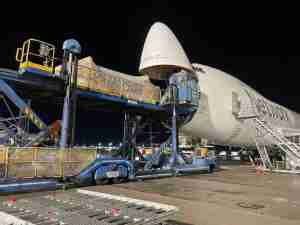The coronavirus hit to the aviation business is as bad as it was expected to be for Boeing Co. and engine-maker General Electric Co., and that is bad enough.
Both companies reported results on Wednesday and the numbers were just ugly. Boeing burned through a whopping $4.7 billion of cash in the first quarter, while GE saw negative free cash flow of $2.2 billion as a virtual halt in global travel demand forced airlines to ground fleets, accelerate retirements of older models and defer deliveries of new planes. Boeing CEO Dave Calhoun has warned that passenger traffic may not recover to 2019 levels for three years and growth in the world’s aircraft fleet may not resume for several years after that; as a result, the company is cutting 10% of its workforce. On GE’s earnings call Wednesday, CEO Larry Culp declined to take a specific view on when the industry would return to pre-virus levels, but acknowledged it will be a “multi-year recovery” as the company makes deep job cuts of its own.
Both GE and Boeing said they will have the liquidity needed to manage through the crisis. That said, GE backed away from a target to reduce net debt to less than 2.5 times its Ebitda by the end of this year, a goal it had reiterated as recently as March. While analysts from Gordon Haskett and Cowen & Co. have questioned whether the company might need to raise additional capital in the equity market, Culp, in an interview, said that isn’t in the current operating plan and pointed to the company’s $47 billion of cash at the end of the first quarter. Boeing, meanwhile, vowed to explore all available funding options. These seemingly include a slice of the $2 trillion government stimulus bill, despite Calhoun’s previous pushback to the Treasury Department’s demand for an equity stake.
The nature of the two companies’ businesses means cash flow will come back at a different pace. Boeing makes its money primarily by selling airplanes, GE by servicing them. The common thinking is that suppliers like GE may get hit harder for longer as airlines rush to retire their oldest, costliest jets at an unprecedented clip. We may indeed be looking at a structural downshift: Planes that aren’t flying anymore don’t need to be serviced and their parts can also be recycled, cannibalizing fresh sales. But GE is arguably in a better position than some of its rivals. Engines made by the company and its CFM joint venture predominantly sit on narrow-body jets that are relatively young, averaging about 10 years old in age. Those planes don’t need as much service work, but they are less likely to be retired and will be the first put back into service given their smaller size. GE also doesn’t necessarily have to wait for passengers to return en masse for demand for services to come back to life, Culp said by phone. Even if a plane flies with only five people on it, it still needs maintenance work after a certain number of takeoffs and landings.
While the aggressive pace of retirements may support demand for new, more fuel-efficient jets over the long term, Boeing, by contrast, is likely to see a slow pace of new deliveries until airlines see demand recover and are confident they can profitably expand their capacity. As such, it’s recalibrating production plans for its 787 Dreamliner and 777X wide-body jets. The 737 Max jet remains grounded and Boeing yet again pushed back the timeline for its return on Wednesday, saying it now expects regulators to allow it to start delivering the jet in the third quarter. That’s a slight shift from its previous call for a mid-2020 return. With 400 undeliverable Max planes sitting in storage and few, if any, airlines interested in taking possession of them any time soon, Boeing will gradually ramp up production to just 31 planes a month over the course of 2021. The company still thinks it can generate positive cash flow next year.
While GE and Boeing were both in turnaround mode when the crisis hit, they were at very different stages of that process. GE had started to show signs of a nascent recovery and there was evidence of that continuing even in the distressed first-quarter numbers. In some ways, the coronavirus crisis may even accelerate the cost cuts and cultural changes GE has been trying to make, CEO Culp said. The company is targeting more than $2 billion of cost cuts and more than $3 billion of cash-preservation moves to adjust to the lower demand environment. Boeing, by contrast, was still reeling from the Max grounding and the reputational damage that entailed. A bevy of charges announced in the first quarter – ranging from $336 million tied to repairs of the so-called pickle fork on its 737 NG plane to an $827 million hit for its KC-46 military tanker – speak to the work that’s still needed to clean up its act.
Both GE and Boeing are in survival mode, but they have the opportunity to emerge from this as better companies.









